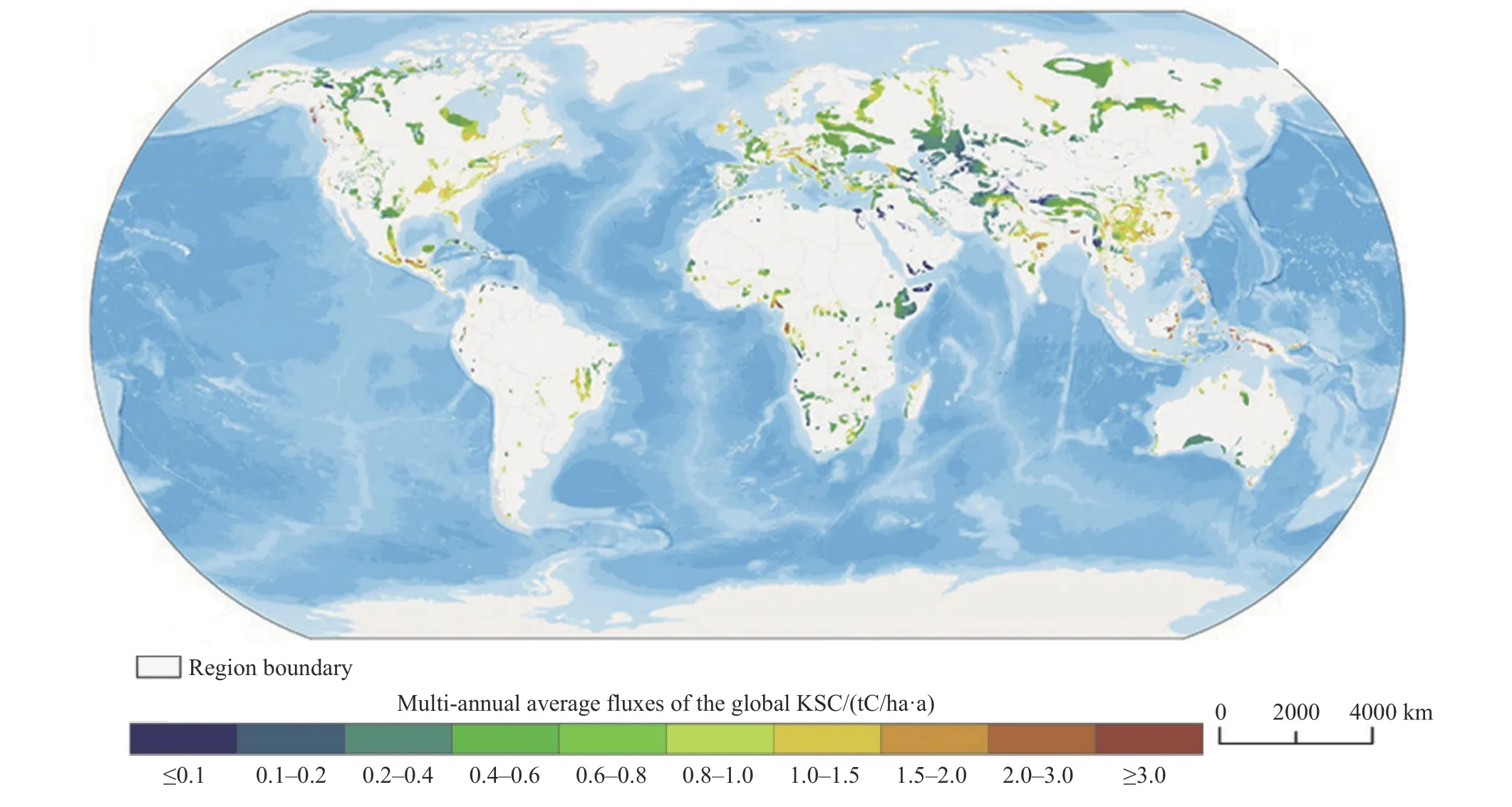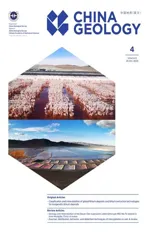Carbon emission reduction: Contribution of karst carbon sinks and practice in China
2023-12-15LiangWangDonghuiWangQiongXiao
Liang Wang, Dong-hui Wang, Qiong Xiao
a Natural Resources Integrated Survey Command Center, China Geological Survey, Ministry of Natural Resources, Beijing 100055, China
b Chengdu Center, China Geological Survey, Ministry of Natural Resources, Chengdu 610200, China
c Institute of Karst Geology, Chinese Academy of Geological Sciences, Guilin 541004, China
Carbonate rocks, as soluble rocks, will dissolve and experience karstification driven by flowing water.This process consumes CO2from the air and converts atmospheric CO2and CO32-of rocks into HCO3-, resulting in the transfer of carbon from the atmosphere to the hydrosphere.Part of those dissolved HCO3-in the groundwater and surface water will degrade as CO2and return to the atmosphere.Furthermore, some HCO3-will be utilized by aquatic photosynthetic organisms to be converted into organic carbon,which could be deposited and stored in the sediments, mainly on the river/lake/reservoir beds.In 1997, Scientists from Institute of Karst Geology, Chinese Academy of Geological Sciences, first proposed that karstification participates in the global carbon cycle and possesses a carbon sink effect.In 2010, they officially proposed the concept of karst carbon sink (KCS), which attracted international attention and sparked heated discussions from the scientific and wider communities (Larson C, 2011).
However, the stability of KCS has been questioned and remain controversial.Some scholars argue that the dissolved HCO3-in water produced by karstification will redeposits as calcite and release CO2back into the atmosphere.The absorbed CO2in the upstream would been discharged into the atmosphere again in the downstream.Even carried into the oceans, it may be sequestered as shells or reefs, along with the release of the CO2.Consequently, there will be no net sequestration of CO2, but rather a transfer to the oceans,where it will equilibrate over time with the atmosphere.In fact, in the karst watershed, the obvious CO2degassing mainly occurs when water flows to caves or karst springs.In the rivers, lakes and oceans, those HCO3-tend to remain in equilibrium with atmospheric CO2and show relatively high stability, rather than being converted into a large amount of CO2back to the atmosphere (Jiang ZC et al., 2022).On the other hand, aquatic plant photosynthesis could promote the conversion of HCO3-into organic carbon, inhibiting CO2degassing and enhancing the potential of carbon sequestration.Many studies in karst areas have also consolidated the stability of KCS.Investigation, monitoring and research on the stability of KCS in the Pearl River watershed have also revealed that only about 15% of the atmospheric CO2absorbed by karstification return to the atmosphere through degassing, 5% deposit on the river beds,and 80% remain stable, implying a greater carbon sink effect(Institute of Karst Geology, 2019).In recent years, with the progress of research, the importance and significance of KCS has been gradually accepted and recognized by more and more scholars around the world.
In China, the area of exposed, covered, and buried carbonate rocks is about 344×104km2, accounting for about one-third of the land area, which indicates the potential of KCS is worthy of significant attention.It is estimated that the KCS flux in China is in the range of 0.01 to 0.072 Pg C/a(Zeng SB et al., 2022).The spatial distribution of KCS in China increases from the north to the south and from the west to the east (Fig.1).The higher KCS mainly occurs in the six southwestern provinces/autonomous regions (Yunnan,Sichuan, Xizang, Hunan, Guangxi and Guizhou),approximately accounting for more than half of the whole nation (Table.1).Considering the great potential, four artificial intervention measures have been developed in order to further enhance the KCS based on the natural karstification process in the southwestern China: (1) breeding and growing plants that adapt to the barren soil environment in karst areas and have fast photosynthetic rates, (2) irrigating by allogenic water from granite, sandstone and shale regions which could enhance karst water corrosion, (3) improving soil to promote plant growth, (4) cultivating suitable aquatic plants to convert inorganic carbon into organic carbon for the better stability of KCS.During 2006-2015, the application of those artificial intervention measures, such as soil improvement and allogenic water irrigation, in the comprehensive treatment of southwestern rocky desertification, greatly increased the KCS(about 25 million tons of carbon), forming a double increase model of ecosystem carbon sink and KCS (China Geological Survey, 2016).

Fig.1.The spatial distributions of KCS intensity in karst area of China (after Zeng SB et al., 2022).

Table 1.The national ranking of actual carbonate weathering carbon sinks of China (after Zeng SB et al., 2022).

Fig.2.The global distribution map of the multiannual average KCS from 2000 to 2014 (after Li HW et al., 2018).
In 2021, the Chinese government published two programmatic documents, the Working Guidance for Carbon Dioxide Peaking and Carbon Neutrality in Full and Faithful Implementation of the New Development Philosophy and Action Plan for Carbon Dioxide Peaking Before 2030, to achieve the goals of carbon emissions peaking and carbon neutrality.Given the huge potential, KCS is listed as one of the most important carbon sinks in those documents, along with forest carbon sink, grassland carbon sink, wetland carbon sink, ocean carbon sink, soil carbon sink and frozen soil carbon sink, in order to consolidate and improve national carbon sink capacity.Currently, the specialized investigation,evaluation and artificial intervention experiments and demonstrations have being carried out in the southwestern China to accelerate the development and utilization of KCS.Globally, carbonate rocks are widely distributed and karst area amounts to 2200×104km2, covering about 15% of the continental area.The global KCS flux calculated by different researchers ranges from 0.2 to 0.9 Pg C/a, with an average of 0.453 Pg C/a (Fig.2; Chen LF et al., 2023), which could theoretically offset the carbon emission produced by the combustion of 298-1343 million tons of standard coal.KCS is sensitive to environment and climate changes.The theories,technologies, and practices of KCS in China could be promoted in other countries where carbonate rocks are widely distributed.In the future, KCS is expected to play more and more important role in the international cooperation on climate change and contribute to the realization of the goals of the Paris Agreement.
杂志排行
China Geology的其它文章
- A three-dimensional Moho depth model beneath the Yemeni highlands and rifted volcanic margins of the Red Sea and Gulf of Aden, Southwest Arabia
- Discovery of bauxite-type helium source rock in Jinzhong basin, central North China and its resource potential evaluation
- Reply: Comment on “Geological mapping and mining prospecting in the Aouli inlier(Eastern Meseta, Morocco) based on remote sensing and geographic information systems (GIS)” by Benaissi et al.(China Geology, 5 (2022))
- Heavy metal pollution assessment in marine sediments in the Northwest coast of Sabah,Malaysia
- Health risk assessment of heavy metals in soils and crops in a mining area (Au-Ag-Cutrona-oil et al.) of the Nanyang Basin, Henan Province, China
- Melt extraction and mineralization: A case study from the Shuangjianzishan supergiant Ag-Pb-Zn deposit (208 Mt), Inner Mongolia, NE China
